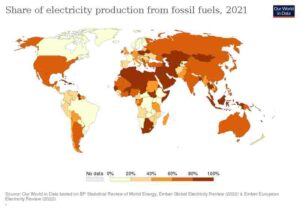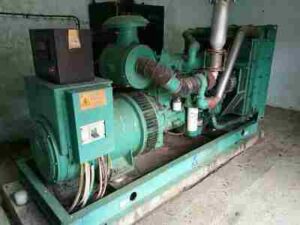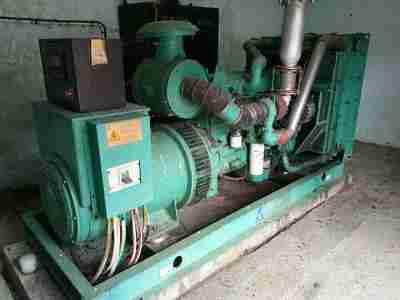7+ Advantages of Non Renewable Energy and Its Conservation
Advantages of non renewable energy are; high capacity, relatively-abundant supply, affordability of extraction and consumption, relative technological simplicity, high relative efficiency, versatility of usage, scalability, and ability to integrate with renewable energy.
This article discusses the advantages of non renewable energy, as follows;
1). High Energy Capacity: one of the Advantages of Non Renewable Energy
Non-renewable energy sources, such as fossil fuels (coal, petroleum, and natural gas) and nuclear energy, are all known for their high energy capacity. This high energy capacity is one of the advantages associated with non-renewable energy. Here, a discussion is provided with regards to the functional capacity of non-renewable energy.
Evaluative Factors for the Capacity of Non Renewable Energy
Factors that can be used to assess the capacity of non renewable energy sources include; energy density, consistency and reliability of energy release/supply, base load power, energy intensity, and range of application.
Fossil fuels are energy-dense substances, estimated to be several billion times mire energy-dense than renewable resources like hydro and wind energy [5]. For example, a small amount of petroleum or natural gas can contain a significant amount of energy. This high concentration of energy allows for the production of large amounts of electricity or power from relatively small quantities of such non-renewable resources.
Compared to renewable alternatives, non-renewable energy sources can provide a consistent and reliable supply of energy. Power plants that depend on fossil fuels, as well as nuclear power plants, can operate continuously, and usually meet energy demand even during peak periods.
It is common for non-renewable energy systems to serve as base load power generators [3], as they provide a stable and constant supply of electricity to the grid. This kind of supply is essential for maintaining a reliable energy-based operation or economy.
Because of their capacity, non-renewable energy sources are used in various industrial processes, including manufacturing and transportation, where high energy intensity and long-term consumption are required.
Also due to their high capacity, non-renewable energy sources are considered reliable for versatile application, and can be used for a wide range of purposes, from electricity generation to powering vehicles, and heating.
Overview of Non Renewable Energy Sources With Minor Reference to Their Output Capacities
Non-renewable energy sources can produce more energy per unit of fuel compared to several of the known renewable sources. Their high energy density allows for the generation of significant power output from these fuels.
Five types of non-renewable energy sources include; petroleum (crude oil), liquefied petroleum gas (LPG), coal, nuclear fuel, and shale gas (natural Gas trapped in shale rock formations).
2). Relatively Abundant Supply as an Advantage of Non-Renewable Energy
One advantage that is associated with non-renewable energy sources, is their relatively abundant supply, which means that they are available in large quantities, at least in the short to medium term. This section throws more light on the availability of non-renewable energy resources.
Abundance, Distribution, Accessibility of Non Renewable Energy Sources
Coal, natural gas, and petroleum can each be discussed separately within the context of their respective abundance on Earth.
Coal is one of the most abundant non-renewable energy resources in the world. It is estimated to have a global reserve of approximately one trillion metric tons [7]. Major coal reserves can be found in regions like Eastern Europe, Asia, and the United States.
Natural gas and petroleum can also be described as being relatively abundant. While their reserves are finite, they are found in various parts of the world. Natural gas, in particular, is the second most abundant non-renewable energy source in many subregions, like the Asia-Pacific [12].
Fossil fuels like coal, petroleum, and natural gas, can be found on every continent, which makes them widely accessible energy sources. This global availability is a core definitive factor to their perceived abundance.
Due to their abundance non-renewable energy sources, especially fossil fuels, have historically been a significant part of the global energy mix. They have been very crucial role in meeting the world's energy demands, and still have a large share in global electricity generation.

Overview of Non Renewable Energy Sources in Terms of Abundance and Supply
Coal is often regarded as the most abundant non-renewable energy source, having vast reserves that are estimated at approximately one trillion metric tons.
Non-renewable energy sources are relatively abundant in the short to medium term, but they are finite resources and have low sustainability in the long term. Their abundance can vary by specific type and region of formation/occurrence.
The supply of non-renewable energy is substantial, with fossil fuels like coal, petroleum and natural gas being the primary contributors. However, their reserves are limited in volume and will eventually become less accessible due to resource depletion.
Top five non-renewable energy sources in terms of socioeconomic prominence are;
1. Petroleum (or crude oil)
2. Natural gas
3. Coal
4. Nuclear fuel
5. Liquefied Petroleum Gas (LPG)
3). Affordability of Extraction and Consumption: One of the Advantages of Non-Renewable Energy
Affordability is an advantage that can be attributed to non-renewable energy sources, especially in terms of both extraction and consumption. Below is a discussion of non-renewable energy with regards to its affordability.
The Affordability of Non Renewable Energy Sources
As implied earlier, fossil fuels, including coal, petroleum, and natural gas, are among the most affordable energy resources, especially when their density and capacity are put into consideration. They are relatively inexpensive to extract from the Earth and process into usable and safe forms that can be stored, transported, and burnt to general electricity and propel automobiles as well as turbine engines.
Electricity that is generated from non-renewable sources such as coal and natural gas, can be cost-effective. For instance, the cost of producing electricity from these sources is often relatively cheap, falling below $0.10 per kilowatt-hour in some cases.
As a result of their cost-effectiveness, non-renewable resources are often accessible to a wide range of consumers. Many people can afford to use the energy derived from these sources, making them widely available and economically productive.
It must be noted that some research indicates that in the long run, renewable energy sources may be more cost-effective than non-renewable energy. However, the affordability of non-renewables can still be a significant advantage in the short term due to its incipient stage of development.
Additional Remarks and Reiterations
Among non-renewable energy sources, coal is often considered to be one of the cheapest, as it requires less complex tools and processes for its extraction, processing and usage.
In general, non-renewable energy sources are perceived as affordable due to their relatively low initial costs of extraction and production. It must however be acknowledged that their use may incur additional cost in terms of environmental impacts, which often involve greenhouse gas emissions, air pollution and other forms of degradation [11].
Affordable energy typically refers to energy sources and services that are reasonably priced and accessible to a wide range of consumers. This term is sometimes used to describe non renewable energy.
It is difficult to identify the most affordable energy source, because affordability of these resources can vary by region and over time. Currently, solar and wind energy are considered highly affordable and economically competitive with fossil fuel resources.
4). Relative Technological Simplicity as an Advantage of Non-Renewable Energy
Another potential benefit of non-renewable energy sources is their relative technological simplicity. This section shows how non-renewable energy aligns with such a description.
Factors that Define the Simplicity of Non Renewable Energy Technologies
Factors that can be used to evaluate the simplicity or complexity of non renewable energy technologies, range from the ease of their extraction and conversion, to the conditions of their processing, convenience of their usage, and the flexibility of adoption of supplementary technologies like carbon capture and utilization (CCUS).
The natural forms in which non-renewable resources, such as fossil fuels (coal, oil, natural gas), are found, usually require relatively straightforward methods of extraction. Once extracted, these resources can be relatively easily converted into storable forms that are suitable and safe for both handling and consumption.
Non-renewable resources are typically available in gaseous, liquid, or solid forms. These forms are convenient for diverse energy applications, and can be readily converted into electricity, heat, or mechanical energy for transportation.
Compared to certain renewable energy technologies, which may involve advanced engineering and complex, innovative infrastructure (like large scale concentrating-solar panels, and offshore wind turbines), non-renewable energy technologies can be simpler to design and implement.
This simplicity can be partly attributed to the fact that non renewable technologies have undergone a prolonged period of modification and development. For instance, traditional power plants and generators that burn fossil fuels are well-established and often require less intricate technology or innovative supplementation.

While they are not inherently carbon-free, non-renewable energy sources can be adapted and retrofitted with sustainable technologies like Carbon Capture and Utilization (CCUS) to minimize their environmental impact. CCUS technologies capture carbon dioxide (CO2) emissions from fossil fuel combustion, and provide a relatively simple/sustainable way to mitigate their greenhouse gas contributions [10].
Overview of Core Concepts Discussed in this Section
Combustion of coal, oil, or natural gas to produce heat energy is a straightforward process that has been used for centuries. While emissions control and efficiency improvements are relatively recent and essential measures, the basic technology remains relatively simple.
Internal combustion engines in vehicles, which rely on petroleum-based fuels, are instances of simple yet effective technology for converting fossil fuels into mechanical energy and electric power.
Carbon capture technology, although still evolving, represents a relatively simple way to capture CO2 emissions from industrial power plants and processes, thereby preventing them from entering the atmosphere.
5). High Relative Energy Efficiency: One of the Advantages of Non-Renewable Energy
Non-renewable energy sources often exhibit high relative energy efficiency compared to certain renewable alternatives. Further elaboration of this statement is provided below;
Factors for Assessing the Relative Efficiency of Non Renewable Energy
Factors that can be used to evaluate the energy efficiency of non renewable resources include; on-demand productivity, consistency of output, and energy density.
Non-renewable energy resources like coal, natural gas, and petroleum, are all applicable for power generation on demand. Power plants that utilize these resources can rapidly respond to changes in energy demand, thereby providing a consistent and reliable energy supply. This contributes to their efficiency in meeting immediate energy needs.
Also, energy systems that utilize non-renewable energy sources, especially those using fossil fuels, are capable of maintaining a relatively constant energy output. These systems are less dependent on external factors like weather conditions (as in the case of solar or wind) that can affect the energy productivity of certain renewables.
Fossil fuels, as well as nuclear radioisotopes, have a high energy density [9], meaning they contain a large amount of energy per unit of volume or weight. This high energy density makes them efficient for energy storage and transportation, which include aviation and long-distance shipping.
Examples of Efficient Non Renewable Energy Technologies
Combined cycle natural gas power plants are known for their relatively high efficiency. These systems utilize both gas and steam turbines to extract more energy from the same amount of fuel compared to older technologies [13], which makes them environmentally and economically efficient.
Although coal power plants have been criticized for their negative environmental impact, some modern coal-fired plants incorporate advanced technologies like supercritical steam cycles that enable them achieve higher efficiency levels.
Non-renewable energy sources like natural gas, can provide consistent and predictable supplies of energy, making them well-suited for baseload power generation that runs on a continuous basis.
Petroleum and natural gas are commonly used as energy-dense fuels for transportation, and their high energy content allows for extended travel distances due to efficient storage of energy.
While non-renewable energy sources offer high relative energy efficiency, it is important to note that this efficiency is often at a trade-off with environmental impacts, including pollution and greenhouse gas emissions. The energy transition to more sustainable and environmentally friendly resources, remains a critical goal for addressing associated environmental issues like climate change.
Comparative Overview of the Efficiency of Non Renewable Energy
Non-renewable energy is generally more efficient because it can be quickly and consistently deployed to meet energy demands. Renewable sources like wind and solar are intermittent and rely on weather conditions, which can lead to high variability in energy production, with avenues for energy loss and low efficiency. In term of operational conditions of use, however, non renewable energy can also incur significant losses in the form of heat.
Wind power is often cited as the most efficient source of power to generate electricity, because it can achieve high conversion efficiencies when the wind is blowing. However, its efficiency is not stable and can vary depending on wind conditions.
The efficiency of non-renewable energy sources can also vary widely. For example, modern natural gas power plants can achieve efficiencies of 60% and above [15], while older coal-fired plants may operate at efficiencies as low as 30% or even less. Renewable sources can also achieve high efficiencies under optimal conditions.
6). Versatility of Usage as an Advantage of Non-Renewable Energy
Non-renewable energy sources, especially fossil fuels like petroleum, natural gas, and coal, are known for their versatility of usage.
This attribute arises from their ability to serve a wide range of applications beyond basic energy generation. More light is shed on the versatility of non-renewable energy in this section.
Tabulated Summary of Common Uses of Non Renewable Energy Resources
The table below shows that non renewable energy has versatile application, with an outline of some resources and their uses.
Non Renewable Energy Resource | Brief Description | Potential Applications |
Petroleum | Petroleum is one of the most versatile non-renewable energy sources, and can be used for various applications. | Petroleum is commonly used in power plants to generate electricity. |
It fuels vehicles such as cars, trucks, ships, and airplanes. | ||
Petroleum serves as a feedstock for the production of plastics, chemicals, and synthetic materials in the petrochemical industry | ||
It is used for residential and industrial heating purposes. | ||
Natural Gas | Natural gas is another highly versatile energy source that finds applications in various fields and processes. | It is used for space heating and water heating in homes and industries. |
Natural gas power plants produce electricity efficiently. | ||
It is the primary fuel for cooking in many households. | ||
Natural gas is used in various industrial applications. | ||
Coal | Although less versatile than oil and natural gas, this fossil fuel is still used in multiple applications, including electricity generation, industrial processes, and heating. | |
Black/Brown/Grey Hydrogen | Produced from non-renewable sources like natural gas and coal [14], black/brown hydrogen has gained attention as a versatile energy carrier. It can be used for fuel cell vehicles, energy storage, and industrial applications. | |
Crude oil-based fuels like gasoline and diesel are critical for transportation, powering cars, trucks, ships, and airplanes. They offer a high energy density and are easy to transport.
Petroleum and natural gas are feedstocks used for the production of a wide range of industrial products, including plastics, detergents, synthetic rubber, and various chemicals [8].
Natural gas itself is commonly used for cooking and heating in residential and commercial buildings due to its clean-burning properties.

Coal and natural gas are both used in power plants to generate electricity. Natural gas power plants are known for their versatility in providing reliable and dispatchable power.
Overview of Some Concepts Discussed
Natural gas is often considered a versatile energy source due to its multiple applications, that include heating, electricity generation, cooking, and mechanical energy production in vehicles.
Non-renewable energy sources, such as oil, natural gas, and coal, offer versatility in energy applications, which makes them suitable for various purposes beyond electricity generation.
7). Scalability of Technologies as an Advantage of Non-Renewable Energy
Scalability is the ability to adjust the size or capacity of a technology or system to meet varying demands, or to expand its operation, with minimal architectural/compositional modification [4]. Non-renewable energy sources, such as fossil fuels and nuclear energy, often exhibit scalability in several ways. Some of these ways are addressed here.
Evaluative Factors for the Scalability of Non Renewable Energy
The scalability of non renewable energy can be analyzed based on its use in large-scale power generation, industrial and commercial systems, transportation, baseload power generation, hybrid systems, and backup supply.
In general, non-renewable energy technologies are well-suited for large-scale power generation. Power plants that are fueled by coal, natural gas, or nuclear reactor-cores can be designed and modified to produce significant amounts of electricity in order to meet the energy needs of entire regions or countries. These power plants can be scaled up or down to match the demand for electricity.
Non-renewable energy sources are commonly utilized in industrial processes and commercial applications. Industries that require large amounts of heat, such as chemical production and steel manufacturing, can easily scale up their non-renewable energy use in order to maintain consistent operations.
Fossil fuels, particularly petroleum-derived products like gasoline and diesel, are the primary energy sources used in the transportation industry. The scalability of gasoline and diesel fuels allows vehicles of all sizes, ranging from small cars to large trucks and ships, to operate efficiently.
Non-renewable energy sources, like coal and nuclear fuel, are often used for baseload power generation. Baseload power provides a reliable and consistent supply of electricity to meet minimum energy demand. These technologies can be scaled to match the baseload requirements of a given area.
As another instance of their scalability and flexible usage, non-renewable energy technologies can be integrated into hybrid systems. For example, combined-cycle power plants can combine natural gas and steam turbines to improve flexibility and efficiency. These systems are adaptable to different load demands.
Both diesel generators and natural gas generators are commonly utilized for backup power in critical facilities such as data centers and hospitals [1]. They can be easily scaled to provide emergency power to these facilities when needed.
Distinct Examples of the Scalability of Non Renewable Energy
Natural gas power plants; nuclear reactors, diesel generators, and fossil fuel-driven vehicles can all be cited in discussions regarding the scalability of non renewable energy sources.
Combined-cycle natural gas power plants are highly scalable and can be expanded to meet increased demand for electricity. They are often utilized for peak load and intermediate load power generation.
Nuclear power plants, while requiring significant initial investment, are scalable and can provide a steady supply of electricity for extended periods of time.
Diesel generators come in various sizes, so that users can choose the appropriate generator capacity on the basis of their backup power needs.
Fossil fuels like gasoline and diesel are versatile and scalable resources used in various transportation modes, ranging from personal vehicles to cargo ships.
8). Ability to Integrate with Renewable Energy
A major advantage associated with non-renewable energy sources is their ability to integrate with renewable energy technologies to create a more balanced and reliable energy mix. This integration can address some of the limitations and issues of intermittency that are associated with renewable energy sources.
Here, non-renewable energy is discussed in line with this description.
Facilitators and Benefits of Non Renewable Energy Integration
Non renewable energy is suitable for integration with renewable resources because it provides steady baseload power, grid stability, and complementary energy storage, all of which support a system's ability to meet energy demands.
Non-renewable energy sources, such as coal and nuclear fuel, can provide steady baseload power, which is essential for maintaining grid stability. Renewable energy sources like wind and solar on the other hand can be intermittent, producing power when the wind blows or the sun shines. Non-renewable sources can fill in the gaps when renewable output is low.
The integration of non-renewable energy can therefore enhance grid stability. When renewable energy sources experience fluctuations, non-renewable sources can quickly adjust their output to compensate, helping to prevent blackouts or grid instability.
Non-renewable energy can complement energy storage systems. Excess electricity that is generated from renewables during periods of high production, can be used to charge these energy storage systems, such as batteries [6]. When the energy stored has been used up, non-renewable sources can be used as backup to release their own stored energy, ensuring a consistent power supply.
Hybrid power plants and systems combine both renewable and non-renewable technologies to optimize energy generation. Such hybrid systems can adapt to changing energy demands and environmental conditions.
During the transition from a predominantly non-renewable energy system to one that relies more on renewables, non-renewable sources can serve as a bridge. They can provide a stable energy supply while renewable infrastructure is being installed, expanded and/or improved.
Lastly, in hybrid systems, non-renewable energy sources can be utilized to meet peak demand. When electricity demand surges, power plants can be quickly ramped up with non renewable inputs, to ensure there is enough power available.
Examples of Technological Applications and Integrations that Rely on Non Renewable Energy
Technological applications and integrations of non renewable energy can be observed with natural gas peaker plants, nuclear energy systems, hybrid systems, and grid management.
Natural gas peaker plants are power plants that run on natural gas and are often used to meet peak electricity demand. They can quickly step their output up or down in response to changing demand, thereby complementing intermittent renewable sources.
Nuclear power plants provide a reliable and steady source of electricity. They can run continuously, which makes them suitable for baseload power generation in combination with renewables.
Hybrid renewable systems generally combine renewable sources like solar and wind with non-renewable sources, such as natural gas or diesel generators, to ensure stability of power supply.
Lastly, grid operators often utilize a mix of renewable and non-renewable sources to balance supply and demand effectively, thereby ensuring that energy is always available.
Why It is Important to Conserve Non Renewable Energy
It is important to conserve non-renewable energy because it is derived from finite resources; and has potential impacts on both urban areas and natural ecosystems in the course of its use. Below is an elaborate discussion highlighting the importance of conserving non renewable energy.
All non-renewable energy sources, including fossil fuels (coal, oil, and natural gas) and uranium (used in nuclear power), are finite resources. Most of them have taken millions of years to form, and current consumption rates far exceed the rate at which they are replenished. Eventually, these resources will be depleted, and if adequate measures are not taken to optimize their consumption rate, future generations will likely face energy scarcity.
The extraction, processing, and burning of non-renewable energy sources are major contributors to environmental problems. For example, burning fossil fuels releases greenhouse gases like carbon dioxide (CO2) into the atmosphere, which contributes to climate change and global warming. Conserving non-renewable energy can help to reduce these harmful emissions, thereby mitigating the impacts of climate change and protecting the environment.
Combustion of fossil fuels releases not only CO2, but also pollutants like sulfur dioxide (SO2), nitrogen oxides (NOx), and particulate matter. These toxic materials can harm air quality and contribute to health problems including various respiratory diseases [2]. In addition, the production and transportation of non-renewable energy sources can result in oil spills and other environmental hazards.
Many nations are heavily reliant on non-renewable energy sources, which can make them highly vulnerable to socioeconomic destabilization as a result of energy supply disruptions or price fluctuations. Conserving these resources can enhance energy security for such countries by reducing dependence on foreign oil and volatile energy markets.
The price of non-renewable energy sources can be volatile due to geopolitical factors, supply constraints, and market dynamics. By conserving non-renewable energy and diversifying the energy mix with renewable resources, economies can become more resilient and immune to energy price shocks.
Transitioning to a sustainable energy future, which relies primarily on renewable sources, is essential in order to combat climate change and reduce the environmental impacts associated with energy production. Conserving non-renewable energy is a crucial step in this transition, as it helps to extend the lifespan of available resources while renewable infrastructure is developed and improved.
Asides the direct production of energy, some non-renewable resources, such as rare earth elements used in electronics and batteries, are essential for modern technology. Conserving non-renewable energy ensures that these resources will be available for future technological advancements.
Conservation is a fundamental principle in the development and utilization of sustainable energy. By using energy more efficiently and sparingly, we can reduce waste and minimize the negative environmental consequences associated with energy production and consumption.
As stated earlier, extracting non-renewable energy sources often involves disrupting natural habitats and ecosystems. Conserving these resources can therefore reduce the need for such extraction, and help protect biodiversity.
Lastly, there is an ethical responsibility to use resources wisely and ensure that future generations have access to the opportunities and resources available at the present. Conserving non-renewable energy is a responsible and ethical step in this direction.
Conclusion
Advantages of non renewable energy are;
1. High Energy Capacity
2. Relatively-Abundant Supply
3. Affordability of Extraction and Consumption
4. Relative Technological Simplicity
5. High Relative Energy Efficiency
6. Versatility of Usage
7. Technologies are Scalable
8. Can be Integrated With Renewable Energy
References
1). Al Rikabi, A.S.; Abdelsalam, S.; Dabo, O. Y. (2023). "Hydrogen fuel cells for backup power applications: Advantages, Challenges, And case studies." Available at: https://www.researchgate.net/publication/369591946_Hydrogen_fuel_cells_for_backup_power_applications_Advantages_Challenges_And_case_studies. (Accessed 1 October 2023).
2). Amster E. D.; Haim, M.; Dubnov, J., Broday, D. M. (2014). "Contribution of nitrogen oxide and sulfur dioxide exposure from power plant emissions on respiratory symptom and disease prevalence." Environ Pollut. 2014 Mar;186:20-8. Available at: https://doi.org/10.1016/j.envpol.2013.10.032. (Accessed 1 October 2023). .
3). Bisercic, A.; Bugaric, U. (2021). "Reliability of Baseload Electricity Generation from Fossil and Renewable Energy Sources." Energy and Power Engineering. 13. 190-206. Available at: https://doi.org/10.4236/epe.2021.135013. (Accessed 1 October 2023).
4). Bondi, A. (2000). "Characteristics of Scalability and Their Impact on Performance." Proceedings Second International Workshop on Software and Performance WOSP 2000. 195-203. Available at: https://doi.org/10.1145/350391.350432. (Accessed 1 October 2023).
5). Bradley, L. (2008). "A Comparison of Energy Densities of Prevalent Energy Sources in Units of Joules Per Cubic Meter." International Journal of Green Energy. 5. 438-455. Available at: https://doi.org/10.1080/15435070802498036. (Accessed 1 October 2023).
6). Chen, T.; Jin, Y.; Lv, H.; Yang, A.; Liu, M.; Chen, B.; Xie, Y.; Chen, Q. (2020). "Applications of Lithium-Ion Batteries in Grid-Scale Energy Storage Systems." Transactions of Tianjin University. 26. Available at: https://doi.org/10.1007/s12209-020-00236-w. (Accessed 1 October 2023).
7). Dávila-Pulido, GI.; González-Ibarra, A. A.; Garza-García, M. (2023). "A brief review on coal reserves, production and possible non-power uses: The case of Mexico." Heliyon. 2023 May 5;9(5):e16043. Available at: https://doi.org/10.1016/j.heliyon.2023.e16043. (Accessed 1 October 2023).
8). Ekejiuba, A. (2021). "Natural Petroleum: Chemistry and Valuable Products Fractions." Available at: https://www.researchgate.net/publication/350790219_Natural_Petroleum_Chemistry_and_Valuable_Products_Fractions. (Accessed 1 October 2023).
9). Feng, L. (2021). "Research on Nuclear Energy and Fossil Fuels in China." IOP Conference Series: Earth and Environmental Science. 621. 012068. Available at: https://doi.org/10.1088/1755-1315/621/1/012068. (Accessed 1 October 2023).
10). Julius W.; Silvia G.; Lila, G.; Ilon, J.; Sergi, L.-A.; Ana, P.; Sabine, P.; Christian, O. A.; Elisabeth, D., (2023). "CCUS or no CCUS? Societal support for policy frameworks and stakeholder perceptions in France, Spain, and Poland." Greenhouse Gases: Science and Technology, Blackwell Publishing, vol. 13(1), pages 48-66, February. Available at: https://doi.org/10.1002/ghg.2195. (Accessed 1 October 2023).
11). Lelieveld, J.; Klingmüller, K.;Pozzer, A.; Burnett, R. T.; Haines, A.; Ramanathan, V. (2019). "Effects of fossil fuel and total anthropogenic emission removal on public health and climate." Proc Natl Acad Sci U S A. 2019 Apr 9;116(15):7192-7197. Available at: https://doi.org/10.1073/pnas.1819989116. (Accessed 1 October 2023).
12). Mohammad, N.; Ishak, W.; Mustapa, S.; Ayodele, B. (2021). "Natural Gas as a Key Alternative Energy Source in Sustainable Renewable Energy Transition: A Mini Review." Frontiers in Energy Research. 9. 625023. Available at: https://doi.org/10.3389/fenrg.2021.625023. (Accessed 1 October 2023).
13). Mude, M. M. N.; Murty, V.; Prasad, B. (2017). "Combined Cycle Power Plant Performance Enhancement Based on Inlet Air Cooling Techniques: A Technical Review." International Journal of Engineering Research and. V6. Available at: https://doi.org/10.17577/IJERTV6IS120126. (Accessed 1 October 2023).
14). Panić, I.; Cuculić, A.; Celic, J. (2022). "Color-Coded Hydrogen: Production and Storage in Maritime Sector." Journal of Marine Science and Engineering. 10. 1995. Available at: https://doi.org/10.3390/jmse10121995. (Accessed 1 October 2023)
15). Thirion, C.; Steyn, J. (2021). "Natural Gas for Power Generation." Available at: https://www.researchgate.net/publication/354863542_Natural_Gas_for_Power_Generation. (Accessed 1 October 2023).





